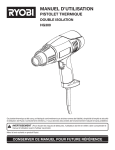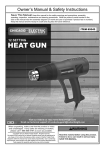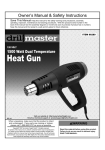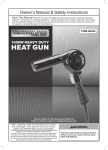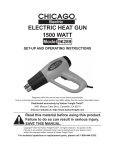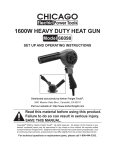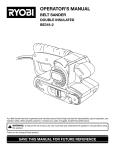Download Ryobi HG300 Operator`s manual
Transcript
OPERATOR’S MANUAL HEAT GUN DOUBLE INSULATED HG300 Your heat gun has been engineered and manufactured to Ryobi’s high standard for dependability, ease of operation, and operator safety. When properly cared for, it will give you years of rugged, trouble-free performance. WARNING: To reduce the risk of injury, the user must read and understand the operator’s manual before using this product. Thank you for buying a Ryobi product. SAVE THIS MANUAL FOR FUTURE REFERENCE TABLE OF CONTENTS n Introduction ..................................................................................................................................................................... 2 �n Important Safety Instructions ....................................................................................................................................... 3-4 �n Specific Safety Rules....................................................................................................................................................... 4 �n Symbols........................................................................................................................................................................ 5-6 �n Electrical .......................................................................................................................................................................... 7 �n Features........................................................................................................................................................................ 8-9 �n Assembly ....................................................................................................................................................................... 10 �n Operation.................................................................................................................................................................. 10-12 n Maintenance .................................................................................................................................................................. 13 n Parts Ordering / Service ................................................................................................................................................ 14 INTRODUCTION This tool has many features for making its use more pleasant and enjoyable. Safety, performance, and dependability have been given top priority in the design of this product making it easy to maintain and operate. 2 IMPORTANT SAFETY INSTRUCTIONS n Keep your work area clean and well lit. Cluttered benches and dark areas invite accidents. n Do not operate power tools in explosive atmospheres, such as in the presence of flammable liquids, gases, or dust. Power tools create sparks which may ignite the dust or fumes. n Keep bystanders, children, and visitors away while operating a power tool. Distractions can cause you to lose control. n Avoid accidental starting. Be sure switch is off before plugging in. Carrying tools with your finger on the switch or plugging in tools that have the switch on invites accidents. n Remove adjusting keys or wrenches before turning the tool on. A wrench or a key that is left attached to a rotating part of the tool may result in personal injury. n Do not overreach. Keep proper footing and balance at all times. Proper footing and balance enables better control of the tool in unexpected situations. n Use safety equipment. Always wear eye protection. Dust mask, nonskid safety shoes, hard hat, or hearing protection must be used for appropriate conditions. n Do not wear loose clothing or jewelry. Contain long hair. Loose clothes, jewelry, or long hair can be drawn into air vents. n Do not use on a ladder or unstable support. Stable footing on a solid surface enables better control of the tool in unexpected situations. ELECTRICAL SAFETY TOOL USE AND CARE WARNING: Read and understand all instructions. Failure to follow all instructions listed below may result in electric shock, fire, and/or serious personal injury. READ THESE INSTRUCTIONS WORK AREA n Use clamps or other practical way to secure and support the workpiece to a stable platform. Holding the work by hand or against your body is unstable and may lead to loss of control. n Do not force tool. Use the correct tool for your application. The correct tool will do the job better and safer at the rate for which it is designed. n Do not use tool if switch does not turn it on or off. Any tool that cannot be controlled with the switch is dangerous and must be repaired. n Disconnect the plug from power source before making any adjustments, changing accessories, or storing the tool. Such preventive safety measures reduce the risk of starting the tool accidentally. n Store idle tools out of the reach of children and other untrained persons. Tools are dangerous in the hands of untrained users. n Maintain tools with care. Keep cutting tools sharp and clean. Properly maintained tools with sharp cutting edges are less likely to bind and are easier to control. n Check for misalignment or binding of moving parts, breakage of parts, and any other condition that may affect the tool’s operation. If damaged, have the tool serviced before using. Many accidents are caused by poorly maintained tools. n Use only accessories that are recommended by the manufacturer for your model. Accessories that may be suitable for one tool, may become hazardous when used on another tool. n Keep the tool and its handle dry, clean and free from oil and grease. Always use a clean cloth when cleaning. Never use brake fluids, gasoline, petroleum-based products, or any strong solvents to clean your tool. Following this rule will reduce the risk of loss of control and deterioration of the enclosure plastic. n Double insulated tools are equipped with a polarized plug (one blade is wider than the other). This plug will fit in a polarized outlet only one way. If the plug does not fit fully in the outlet, reverse the plug. If it still does not fit, contact a qualified electrician to install a polarized outlet. Do not change the plug in any way. Double insulation eliminates the need for the threewire grounded power cord and grounded power supply system. n Avoid body contact with grounded surfaces such as pipes, radiators, ranges, and refrigerators. There is an increased risk of electric shock if your body is grounded. n To reduce the risk of fire or electric shock, do not expose this product to rain or moisture. Store indoors. n Do not abuse the cord. Never use the cord to carry the tools or pull the plug from an outlet. Keep cord away from heat, oil, sharp edges, or moving parts. Replace damaged cords immediately. Damaged cords increase the risk of electric shock. n When operating a power tool outside, use an outdoor extension cord marked “W-A” or “W”. These cords are rated for outdoor use and reduce the risk of electric shock. PERSONAL SAFETY n Stay alert, watch what you are doing and use common sense when operating a power tool. Do not use tool while tired or under the influence of drugs, alcohol, or medication. A moment of inattention while operating power tools may result in serious personal injury. n Dress properly. Do not wear loose clothing or jewelry. Contain long hair. Keep your hair, clothing, and gloves away from moving parts. Loose clothes, jewelry, or long hair can be caught in moving parts. 3 IMPORTANT SAFETY INSTRUCTIONS SERVICE n When servicing a tool, use only identical replacement parts. Follow instructions in the Maintenance section of this manual. Use of unauthorized parts or failure to follow Maintenance Instructions may create a risk of shock or injury. n Tool service must be performed only by qualified repair personnel. Service or maintenance performed by unqualified personnel may result in a risk of injury. SPECIFIC SAFETY RULES n Protect your hearing. Wear hearing protection during extended periods of operation. Following this rule will reduce the risk of serious personal injury. n The nozzle of the heat gun becomes very hot during operation and should not be touched until the tool has cooled. Always hold the tool by the insulated gripping surface to reduce the risk of serious personal injury. n Heat guns produce very high temperatures and must be used with caution to prevent combustible material from igniting. Keep tool in constant motion; do not stop or dwell in one spot. Following this rule will reduce the risk of fire or serious personal injury. n Excessive heat can generate fumes which may be dangerous when inhaled. Wear a dust respirator mask or dual filter respirator mask when using the heat gun. Following this rule will reduce the risk of serious personal injury. n Inspect tool cords periodically and, if damaged, have repaired at your nearest Authorized Service Center. Constantly stay aware of cord location. Following this rule will reduce the risk of electric shock or fire. n Check damaged parts. Before further use of the tool, a guard or other part that is damaged should be carefully checked to determine that it will operate properly and perform its intended function. Check for alignment of moving parts, binding of moving parts, breakage of parts, mounting, and any other conditions that may affect its operation. A guard or other part that is damaged should be properly repaired or replaced by an authorized service center. Following this rule will reduce the risk of shock, fire, or serious injury. n Keep a fully charged fire extinguisher close at hand for emergency use. Following this rule will reduce the risk of fire or serious injury. n Do not leave the heat gun unattended while running or cooling down. Always set tool on a flat, level surface so nozzle tip is directed upwards, away from supporting surface, while running or cooling down. Following this rule will reduce the risk of fire or serious injury. n Know your power tool. Read operator’s manual carefully. Learn its applications and limitations, as well as the specific potential hazards related to this tool. Following this rule will reduce the risk of electric shock, fire, or serious injury. n Always wear safety glasses. Everyday eyeglasses have only impact-resistant lenses; they are NOT safety glasses. Following this rule will reduce the risk of serious personal injury. n Make sure your extension cord is in good condition. When using an extension cord, be sure to use one heavy enough to carry the current your product will draw. A wire gauge size (A.W.G.) of at least 14 is recommended for an extension cord 50 feet or less in length. A cord exceeding 100 feet is not recommended. If in doubt, use the next heavier gauge. The smaller the gauge number, the heavier the cord. An undersized cord will cause a drop in line voltage resulting in loss of power and overheating. n Save these instructions. Refer to them frequently and use them to instruct others who may use this tool. If you loan someone this tool, loan them these instructions also. WARNING: Fumes created by heating some materials may contain chemicals known to cause cancer, birth defects, or other reproductive harm. Some examples of these chemicals are: • lead from lead-based paints, • crystalline silica from bricks and cement and other masonry products, and • arsenic and chromium from chemically-treated lumber. Your risk from these exposures varies, depending on how often you do this type of work. To reduce your exposure to these chemicals: work in a well-ventilated area and work with approved safety equipment, such as those masks that are specially designed to filter out microscopic particles. 4 SYMBOLS Some of the following symbols may be used on this tool. Please study them and learn their meaning. Proper interpretation of these symbols will allow you to operate the tool better and safer. SYMBOL NAME DESIGNATION/EXPLANATION V Volts Voltage A Amperes Current Hz Hertz Frequency (cycles per second) W Watt Power Minutes Time Alternating Current Type of current Direct Current Type or a characteristic of current No Load Speed Rotational speed, at no load Class II Construction Double-insulated construction Per Minute Revolutions, strokes, surface speed, orbits etc., per minute Wet Conditions Alert Do not expose to rain or use in damp locations. Read The Operator’s Manual To reduce the risk of injury, user must read and understand operator’s manual before using this product. Eye Protection Always wear safety goggles or safety glasses with side shields and a full face shield when operating this product. Safety Alert Precautions that involve your safety. No Hands Symbol Failure to keep your hands away from the blade will result in serious personal injury. No Hands Symbol Failure to keep your hands away from the blade will result in serious personal injury. No Hands Symbol Failure to keep your hands away from the blade will result in serious personal injury. No Hands Symbol Failure to keep your hands away from the blade will result in serious personal injury. Hot Surface To reduce the risk of injury or damage, avoid contact with any hot surface. min no .../min 5 SYMBOLS The following signal words and meanings are intended to explain the levels of risk associated with this product. SYMBOL SIGNAL MEANING DANGER: Indicates an imminently hazardous situation, which, if not avoided, will result in death or serious injury. WARNING: Indicates a potentially hazardous situation, which, if not avoided, could result in death or serious injury. CAUTION: Indicates a potentially hazardous situation, which, if not avoided, may result in minor or moderate injury. CAUTION: (Without Safety Alert Symbol) Indicates a situation that may result in property damage. SERVICE WARNING: Servicing requires extreme care and knowledge and should be performed only by a qualified service technician. For service we suggest you return the product to your nearest AUTHORIZED SERVICE CENTER for repair. When servicing, use only identical replacement parts. To avoid serious personal injury, do not attempt to use this product until you read thoroughly and understand completely the operator’s manual. Save this operator’s manual and review frequently for continuing safe operation and instructing others who may use this product. WARNING: The operation of any power tool can result in foreign objects being thrown into your eyes, which can result in severe eye damage. Before beginning power tool operation, always wear safety goggles or safety glasses with side shields and a full face shield when needed. We recommend Wide Vision Safety Mask for use over eyeglasses or standard safety glasses with side shields. Always use eye protection which is marked to comply with ANSI Z87.1. SAVE THESE INSTRUCTIONS 6 ELECTRICAL DOUBLE INSULATION EXTENSION CORDS Double insulation is a concept in safety in electric power tools, which eliminates the need for the usual threewire grounded power cord. All exposed metal parts are isolated from the internal metal motor components with protecting insulation. Double insulated tools do not need to be grounded. When using a power tool at a considerable distance from a power source, be sure to use an extension cord that has the capacity to handle the current the tool will draw. An undersized cord will cause a drop in line voltage, resulting in overheating and loss of power. Use the chart to determine the minimum wire size required in an extension cord. Only round jacketed cords listed by Underwriter’s Laboratories (UL) should be used. When working outdoors with a tool, use an extension cord that is designed for outside use. This type of cord is designated with “WA” on the cord’s jacket. Before using any extension cord, inspect it for loose or exposed wires and cut or worn insulation. WARNING: The double insulated system is intended to protect the user from shock resulting from a break in the tool’s internal insulation. Observe all normal safety precautions to avoid electrical shock. NOTE: Servicing of a tool with double insulation requires extreme care and knowledge of the system and should be performed only by a qualified service technician. For service, we suggest you return the tool to your nearest authorized service center for repair. Always use original factory replacement parts when servicing. **Ampere rating (on tool faceplate) 0-2.0 2.1-3.4 Cord Length ELECTRICAL CONNECTION This tool has a precision-built electric motor. It should be connected to a power supply that is 120 volts, 60 Hz, AC only (normal household current). Do not operate this tool on direct current (DC). A substantial voltage drop will cause a loss of power and the motor will overheat. If your tool does not operate when plugged into an outlet, double-check the power supply. 3.5-5.0 5.1-7.0 7.1-12.0 12.1-16.0 Wire Size (A.W.G.) 25' 16 16 16 16 14 14 50' 16 16 16 14 14 12 100' 16 16 14 12 10 — **Used on 12 gauge - 20 amp circuit. NOTE: AWG = American Wire Gauge WARNING: Keep the extension cord clear of the working area. Position the cord so that it will not get caught on lumber, tools or other obstructions while you are working with a power tool. Failure to do so can result in serious personal injury. WARNING: Check extension cords before each use. If damaged replace immediately. Never use tool with a damaged cord since touching the damaged area could cause electrical shock resulting in serious injury. 7 FEATURES PRODUCT SPECIFICATIONS Heat Output.............................................................................................................................................. 300˚F/600˚F/1100˚F Input ..................................................................................................................................... 120 V, 60 Hz, AC only, 10 Amps Net Weight....................................................................................................................................................................1.9 lbs. SCRAPER NOZZLE NOSE CONE TEMPERATURE SWITCH SUPPORT STAND HANGER Fig. 1 8 FEATURES KNOW YOUR HEAT GUN POWER CORD See Figure 1. Before attempting to use this product, familiarize yourself with all operating features and safety rules. An extra-long 10-foot power cord gives you more freedom of movement and placement flexibility when working with your heat gun. TEMPERATURE SWITCH SCRAPER NOZZLE Your heat gun’s conveniently located switch allows you to select one of three available operating temperatures. A scraper nozzle attachment is provided with your heat gun to expand its possible uses. NOSE CONE HANGER The nose cone on your heat gun can be removed for work in confined spaces. A hanger is located in the support stand of your heat gun. SUPPORT STAND Your heat gun has a built-in support stand for ease of use and convenient cool down. 9 ASSEMBLY UNPACKING WARNING: This product has been shipped completely assembled. If any parts are missing do not operate this tool until the missing parts are replaced. Failure to do so could result in possible serious personal injury. n Carefully remove the tool and any accessories from the box. Make sure that all items listed in the packing list are included. n Inspect the tool carefully to make sure no breakage or damage occurred during shipping. n Do not discard the packing material until you have carefully inspected and satisfactorily operated the tool. n If any parts are damaged or missing, please call 1-800-525-2579 for assistance. WARNING: Do not attempt to modify this tool or create accessories not recommended for use with this tool. Any such alteration or modification is misuse and could result in a hazardous condition leading to possible serious personal injury. PACKING LIST Heat Gun Scraper Nozzle Operator’s Manual Warranty Registration Card WARNING: Do not connect to power supply until assembly is complete. Failure to comply could result in accidental starting and possible serious personal injury. OPERATION READ THIS INSTRUCTION WARNING: WARNING: Do not allow familiarity with tools to make you careless. Remember that a careless fraction of a second is sufficient to inflict serious injury. Use extreme care when stripping paint. The peelings, residue, and vapors of paint may contain lead, which is poisonous. Any pre-1977 paint may contain lead and paint applied to homes prior to 1950 is likely to contain lead. Once deposited on surfaces, hand to mouth contact can result in the ingestion of lead. Exposure to even low levels of lead can cause irreversible brain and nervous system damage; young and unborn children are particularly vulnerable. Before beginning any paint removal process, you should determine whether the paint you are removing contains lead. This can be done by your local health department or by a professional who uses a paint analyzer to check lead content of the paint to be removed. LEAD-BASED PAINT SHOULD ONLY BE REMOVED BY A PROFESSIONAL AND SHOULD NOT BE REMOVED USING A HEAT GUN. WARNING: Always wear safety goggles or safety glasses with side shields, a dust respirator mask or dual filter respirator mask, and protective gloves when operating the heat gun. Failure to do so could result in possible serious injury. WARNING: Do not use any attachments or accessories not recommended by the manufacturer of this tool. The use of attachments or accessories not recommended can result in serious personal injury. APPLICATIONS Persons removing paint should follow these guidelines: n Move the workpiece outdoors. If this is not possible, keep the work area well ventilated. Open the windows and put an exhaust fan in one of them. Be sure the fan is moving the air from inside to outside. You may use this tool for the purposes listed below: n Soften paint, caulking and putty for easier removal n Soften adhesives to help remove stickers, floor tiles, wallpaper, etc. n Heating plastic and metal for bending n Remove or cover any carpets, rugs, furniture, clothing, cooking utensils, and air ducts. n Shrink tubing for electrical work n Place drop cloths in the work area to catch any paint chips or peelings. Wear protective clothing such as extra work shirts, overalls, and hats. n Shrink plastic film for wrapping or weatherproofing n Loosen rusted nuts, bolts, and fittings 10 OPERATION STARTING/STOPPING THE HEAT GUN n Work in one room at a time. Furnishings should be removed or placed in the center of the room and covered. Work areas should be sealed off from the rest of the dwelling by sealing doorways with drop cloths. See Figure 2. The heat gun is started by sliding the power switch upward into either the HI, MED, or LO position. To stop, slide the switch all the way down to the OFF (O) position. n Children, pregnant or potentially pregnant women, and nursing mothers should not be present in the work area until the work is done and all clean up is complete. ADJUSTING THE TEMPERATURE See Figure 2. The temperature of the heat gun is controlled by the switch. From the OFF position, slide the switch up one click for low temperature (300˚F), two clicks for medium temperature (600˚F) and all the way to the top for high temperature (1100˚F). NOTE: The proper amount of heat necessary for a specific application depends on the distance between the nozzle and workpiece and the length of time heat is applied. Experiment with scrap materials and start with the lowest temperature range. Be cautious when working until the proper combination of heat, distance and time has been determined. n Wear a dust respirator mask or a dual filter (dust and fume) respirator mask which has been approved by the Occupational Safety and Health Administration (OSHA), the National Institute of Safety and Health (NIOSH), or the United States Bureau of Mines. These masks and replaceable filters are readily available at major hardware stores. Be sure the mask fits. Beards and facial hair may keep masks from sealing properly. Change filters often. DISPOSABLE PAPER MASKS ARE NOT ADEQUATE. n Use caution when operating the heat gun. Keep the heat gun moving as excessive heat will generate fumes n Keep food and drink out of the work area. Wash hands, arms and face and rinse mouth before eating or drinking. Do not smoke or chew gum or tobacco in the work area. n Clean up all removed paint and dust by wet mopping the floors. Use a wet cloth to clean all walls, sills, and any other surface where paint or dust is clinging. DO NOT SWEEP, DRY DUST, OR VACUUM. Use a high phosphate detergent or trisodium phosphate (TSP) to wash and mop areas. TEMPERATURE SWITCH n At the end of work session, put the paint chips and debris in a double plastic bag, close it with tape or twist ties, and dispose of properly. Fig. 2 HANDS-FREE OPERATION n Remove protective clothing and work shoes in the work area to avoid carrying dust into the rest of the dwelling. Wash work clothes separately. Wipe shoes off with a wet rag that is then washed with the work clothes. Wash hair and body thoroughly with soap and water. See Figure 3. The heat gun has a flat bottom surface that acts as a support stand to allow hands-free operation and cooling. Rest the tool on a flat surface and make sure the cord placement does not cause the heat gun to tip over. NOTE: Do not leave heat gun unattended while it is running or cooling down. Always set on a flat, level surface with nozzle tip directed upwards, away from supporting surface. WARNING: This heat gun generates extremely high temperatures. Hidden areas such as behind walls, ceilings, floors, soffit boards, and other panels may contain flammable materials that could be ignited by the heat gun when working in these locations. Keep tool in constant motion; do not stop or dwell in one spot as the panel or material behind it may ignite. The ignition of these materials may not be readily apparent and could result in property damage and injury to persons. SAVE THIS INSTRUCTION WARNING: Do not direct hot tip or nozzle toward clothing, hands or other body parts. Intense heat from tip or nozzle can cause serious burns or cause clothing to ignite. SUPPORT STAND SAVE THIS INSTRUCTION 11 Fig. 3 OPERATION INSTALLING SCRAPER NOZZLE See Figure 4. The scraper nozzle reduces the airflow from a circular area to a wide, narrow line. This nozzle can be used for removing paint, and for softening and forming acrylic sheets, vinyl floor tiles, linoleum, and laminate surfaces. NOTE: Install or remove attachment only when both the heat gun nozzle and the scraper nozzle are cool. HEAT GUN NOZZLE REMOVING THE NOSE CONE See Figure 5. The nose cone helps to limit exposure to the extremely hot nozzle when the heat gun is in use. However, the nose cone can be removed to allow use of the heat gun in tight spaces. NOTE: Always reinstall the nose cone when finished. SCRAPER NOZZLE To remove: n Unplug the heat gun. n With nozzle pointed away from you, rotate the nose cone slightly clockwise and remove. Fig. 4 WARNING: The nozzle of the heat gun is extremely hot during use. It will stay hot for several minutes, depending on room temperature. Allow heat gun to cool before attempting to install or remove the nose cone to avoid possible serious personal injury. NOSE CONE To reinstall: n Unplug the heat gun. n Slide nose cone over the heat gun nozzle. n Seat the nose cone against the body of the heat gun by aligning tabs on heat gun body to notches on base of nose cone. HEAT GUN NOZZLE n Rotate the nose cone counterclockwise to secure. USING THE HANGER See Figure 6. The heat gun has a hanger recessed into the support stand. To use, simply slide your finger into the opening underneath the hanger and flip the hanger out and away from the support stand. Fig. 5 HANGER 12 Fig. 6 MAINTENANCE WARNING: WARNING: When servicing, use only identical Ryobi replacement parts. Use of any other parts may create a hazard or cause product damage. Always unplug the heat gun before performing any type of maintenance. Following this rule will reduce the risk of serious personal injury. CLEANING THE HEAT GUN WARNING: The heat gun and nozzle attachment should be kept clean, dry, and free of oil or grease. Only a mild soap and damp cloth should be used to clean the heat gun. Do not allow liquid to enter the tool. The high temperatures of the heat gun will cause the nozzle to turn dark over time. This is normal and will not affect its performance or life. Ventilation openings must be kept clean and free of foreign matter. The most effective method of cleaning the vents is with compressed air. Do not attempt to clean by inserting pointed objects through the openings. Always wear safety goggles or safety glasses with side shields during power tool operation or when blowing dust. If operation is dusty, also wear a dust mask. GENERAL MAINTENANCE Avoid using solvents when cleaning plastic parts. Most plastics are susceptible to damage from various types of commercial solvents and may be damaged by their use. Use clean cloths to remove dirt, dust, oil, grease, etc. WARNING: STORAGE Do not at any time let brake fluids, gasoline, petroleumbased products, penetrating oils, etc., come in contact with plastic parts. Chemicals can damage, weaken or destroy plastic which may result in serious personal injury. Always allow the heat gun and nozzle attachments to cool to room temperature before storing. Store the heat gun out of reach of children and untrained individuals. Electric tools used on fiberglass material, wallboard, spackling compounds, or plaster are subject to accelerated wear and possible premature failure because the fiberglass chips and grindings are highly abrasive to bearings, brushes, commutators, etc. Consequently, we do not recommended using this tool for extended work on these types of materials. However, if you do work with any of these materials, it is extremely important to clean the tool using compressed air. The nozzle of the heat gun will stay hot for several minutes after use. Always allow heat gun to cool before storage. Following this rule will reduce the risk of serious personal injury or property damage. WARNING: LUBRICATION All of the bearings in this tool are lubricated with a sufficient amount of high grade lubricant for the life of the unit under normal operating conditions. Therefore, no further lubrication is required. 13 OPERATOR’S MANUAL HEAT GUN DOUBLE INSULATED HG300 • SERVICE Now that you have purchased your tool, should a need ever exist for repair parts or service, simply contact your nearest Ryobi Authorized Service Center. Be sure to provide all pertinent facts when you call or visit. Please call 1-800-525-2579 for your nearest Ryobi Authorized Service Center. You can also check our web site at www.ryobitools.com for a complete list of Authorized Service Centers. • MODEL NO. AND SERIAL NO. The model number of this tool will be found on a plate attached to the motor housing. Please record the model number and serial number in the space provided below. • HOW TO ORDER REPAIR PARTS When ordering repair parts, always give the following information: • MODEL NUMBER • SERIAL NUMBER HG300 RYOBI TECHNOLOGIES, INC. 1428 Pearman Dairy Road, Anderson, SC 29625 Post Office Box 1207, Anderson, SC 29622-1207 Phone 1-800-525-2579 www.ryobitools.com 983000-565 9-04 14














